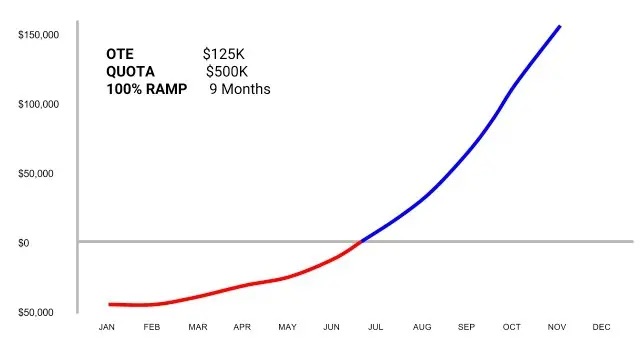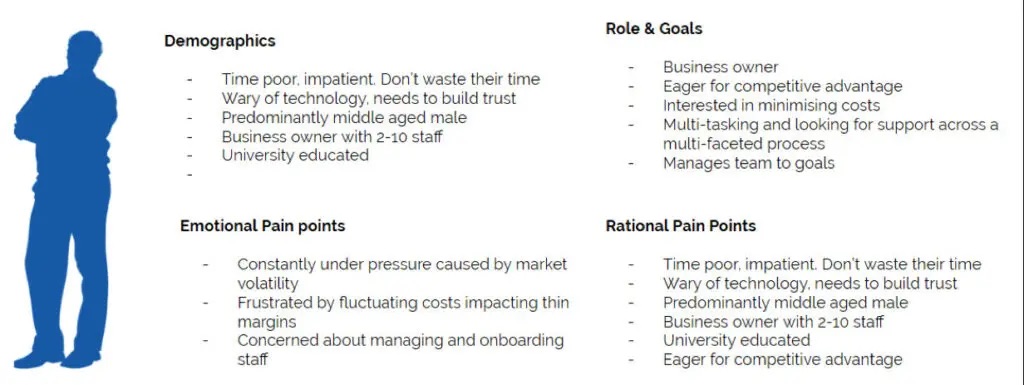When it comes to being a SaaS business leader, you want your salespeople as effective as possible. You need them hitting their numbers, so that you can hit your numbers.
If you’ve got half your sales team only bringing in 80% of their quota, you won’t achieve the growth you are after.
So when you hire a new salesperson, how long does it take for you to ramp them up to 100% productivity? This is your ramp time.
Why is ramp time important?
If it takes you 10 months to get your sales rep to 100% productivity, that’s an underutilized asset that’s causing a drain on your business. It’s draining the cash flow because they haven’t effectively contributed to the bottom line, or your revenue targets.
So the aim with your ramp time is to decrease it as much as possible, so you can get the most out of your team. It also helps you learn quickly whether the sales rep is going to be successful in the role or not.

Getting the basics right
Before even thinking about “training” and all of those other things that contribute to a new hire onboarding process, you’ve got to get the basics right.
There’s so many instances where I see a SaaS leader bringing on a new salesperson, and they don’t even have a computer set up for their first day. They don’t have desk space. They don’t have network access. They don’t have training materials to read. Instead, they are sitting around being totally unproductive.
The reason this happens is usually just flat out laziness, or people just being disorganised. So there is absolutely no reason why a new team member shouldn’t hit the ground running with a desk, a computer, access to their email, and any other tools or paperwork they need. They need these things to even be remotely productive.
You also want to make sure that you are coordinating this first day onboarding process with other departments. Speak with IT, speak with the office manager, speak to someone in accounting and finance. Don’t leave any stone unturned.
Not only does this make sure you are giving yourself and your staff the best chance to have an impact on day one, but it also gives the new hire a great feeling that, “Hey, this company’s got their shit together and they’re ready to help me be successful.”
A new hire will also want to know “who’s who in the zoo”. Who are the people to talk to if they’ve got issues in finance? Who do they need to speak to if perhaps their manager’s not performing well? What happens if there’s any sort of conflict in the office? What happens if they need to get a new pen and paper, or they’ve got an IT issue? People need to know and understand these things to be productive and reach their sales potential.
All of these wheels should be set in motion as soon as you make the hire, so that you are ready and prepared prior to the start date.
Think about the culture
It’s important to give your new hire a really good understanding of the type of company they have joined. This is all about your culture and the vision of the business.
If you’re a smaller SaaS startup, consider bringing in the CEO or the Founder to talk to the new hire about why they decided to start the business. What was the problem they were really trying to solve.
Even if you’re in a bigger business, you still want to be educating any new hires about why the company exists. Get them accustomed to your vision, your mission statement and your values. It will show them how their contribution will count and how they are expected to interact with customers.
Beyond the basics
Once you’ve enabled a new hire with the basics and culture, you’ve got to start thinking about the next step, and that’s giving them the company-specific skills that will enable them to be successful. You can’t expect a new salesperson to come in and have the same skill set as one of your seasoned sales professionals who’s been with you for years.
At this stage you should develop a competency based plan to get them up to the minimum viable skill set for the role. The minimum viable skill set is going to vary based on your customers, your sales process, and the type of role you have hired.
Develop a competency based plan to get new hires up to the minimum viable skill set for the role.
The key to identifying what the minimum viable skills for a role are, is to review your sales process. Let’s say you’ve just hired a sales development rep for example. At the end of the first week, they’re probably not going to be able to run demonstrations of the product. But they might be well enough equipped to start sending out emails to your clients.
So start thinking about those smaller milestones they can work towards and put them into a competency based learning plan. Make sure that you can actually test each of the competencies at each milestone, that way they can move onto the next skill when they are ready. All of these small incremental steps are going to get them closer to securing larger deals for your business.
The big thing about effective competency testing is that not only does it show that your new hires are acquiring skills, and they’re working hard to make themselves a success in the organisation. But it also, and perhaps more importantly, can help you identify those poor hires more quickly. Because the longer you have a bad hire going through this process, the more expensive it is going to be to make that number back up.
9 Steps to Effectively Onboard a New Sales Hire
This process will help you onboard new hires, and identify and move on from poor hires more quickly. It is everything that needs to happen once the basics and cultural side of things are out of the way.
There’s nine steps here, but you definitely can’t take it all in at once. Your new hires need to take this in over time, and you need to dedicate time to educating them throughout their life in the business.
Step 1 – Understand your customers
The first step is to help a new hire understand your customers. If they can walk a mile in their shoes, they can actually start to have the empathy they need to succeed as a salesperson.

Companies like HubSpot actually take this a step further. They have all their sales reps go and create inbound marketing campaigns (which is what their software helps businesses do). So their understanding of the customer goes a long way beyond just having book smarts about them. They then also have real hands-on experience of what it’s like to work with the marketing campaigns their customers do.
Step 2 – Learn about your industry
When a client is speaking to a sales rep, they don’t want to be speaking to someone who’s just fresh into the industry. They don’t usually appreciate the challenges and opportunities, or even more generally just the industry landscape.
If you’re not knowledgeable on the industry, it’s really hard to build a trusting relationship with your prospects and potential customers.
To help get a sales rep up to scratch from an industry perspective, you need to leverage other resources within your business.
Don’t just rely on the sales manager to onboard a new hire. Encourage the product managers, technical leads and leadership team to participate in the process. These people will all have a slightly different perspective on the key challenges in the industry, and can help give the salesperson a more rounded view.
Step 3 – Know your product
When you’re talking about SaaS solutions, it’s super important to have an intimate knowledge of your product. The only way that someone can do that is by having hands-on use of the technology.
A lot of it comes down to employee curiosity to get in there and start playing with the tools. But you’ve got to take it beyond that, just to make sure that people have a base level of knowledge.
One of the best ways to test this competency is to have people set up organisations with your particular tool, and effectively on-board themselves as customers. This validates that they know and understand how to do it quickly and easily.
Step 4 – Learn the sales playbook
This goes back to understanding the minimum viable skill set. Ultimately, the sales playbook should be the bible of how sales is done within the organisation. From when you go to acquire or receive a new lead, all the way to when you win new business.
Someone can access a lot of important sales information from the playbook. It helps a new hire get a holistic view of how the sales process works, and it also helps you identify how you can help them master the most important elements, so they are successful as quickly as possible.
It goes beyond just giving them a folder with a bunch of information in it. You need to help them understand where they sit in the process, and how they can impact the success of the business as a whole through their sales.
Step 5 – Understand your territory
When someone starts a new sales role, they are typically given a geographic territory where they’ll be focusing their energy. Or, they may get given leads from a particular segment of the market.
This is a really important part in the onboarding process, because once someone knows what their sales territory is going to be it gives them a lens to absorb future learnings through. About the product, and about the sales process.
It puts them in a better place to learn and shape their future for success.
Step 6 – Build your business plan with sales math
Sales is a great job, purely because you get to run your own business (within a business). So the next part of the onboarding process is about building out a business plan and backing it up with sales math.
You’ve got a finite number to hit at the end of the month, the quarter, or the year, and you can map out a path to achieve that number by looking at the metrics that enable you to close that business.
Being new to a business, a new hire probably won’t immediately have that data at hand. But there are a bunch of people who are probably already being successful from a sales perspective. The sales manager’s role is to guide a new hire with the sort of leading activities that can help them be successful as quickly as possible.
For example, you may know that if you get ten meetings a week, and you convert two of those meetings into opportunities, and one of those opportunities into a sale, then you will get four sales a month. It’s never going to be perfect from a numbers perspective, but it helps a new salesperson feel more confident that they can hit their numbers if they get the activity side of things right
Step 7 – Start skill development with theory and then training
This is really where the rubber hits the road from a sales perspective. Once you are confident a new hire has that depth of knowledge they need, it’s now about honing their craft to have better conversations with customers.
Each organisation is going to have a slightly different flavour or set of skills. And more importantly, each different hire is going to have a different level of selling ability.
What’s really important when it comes to scalable growth is to create consistency in the sales process, which goes beyond the sales playbook. By having a consistent process, you have a consistent set of skills that you can then coach and motivate your team to use. Then they can learn from each other and grow as a unit.
What’s really important when it comes to scalable growth is to create consistency in the sales process, which goes beyond the sales playbook.
There are three main ways you can look at skill development and training:
- Engage an external person to come in and do one-off sales training (Least desirable)
- Engage an external person to come in and take people on an educational path, or;
- Have an internal trainer on your staff
The key is that it’s not just a one-off set of skills training. This isn’t something that you can set and forget. If you don’t practice and continue to reinforce the training, it’s never going to set in and you’re never going to get consistency in the sales process.
This is all just the start of the skill development. As you start building on that minimum viable skill set, you will begin to train different elements of the skills that are required.
Step 8 – Roleplay
Effective sales roleplays are more than just phone calls… They are also about emails, voicemails, product demonstrations and anything else your rep will do in the role from a customer-facing perspective.
You shouldn’t be sending your reps out into the wild without first having them practice amongst themselves, and then to a manager or an executive in the business, to see how they perform under pressure.
It’s about turning the skills and training into practice. Genuine practice, in roleplays with colleagues. Your goal is to get all of these high impact moments in alignment with your sales process, appropriate for your business, and at a level that will help a new hire close deals.
Step 9 – Model successful behaviour
At this stage a new hire has a great understanding of your customer, the industry and your sales process. You’ve even got them to practice roleplays of impactful sales situations.
But perhaps the most important part of decreasing ramp time is by modeling successful behaviour. You want your salespeople reviewing and following the best reps in the business, and mirroring what they are doing.
Get them to sit in on their phone calls or at their desk for a few hours to see how they operate with inbound leads, how they answer emails, or how they interact with customers. Even just how they plan out their day to maximise their time, is going to provide a huge amount of value for your new hire.
As the famous Benjamin Franklin quote goes:
“Tell me and I forget, teach me and I may remember, involve me and I learn.”
Conclusion
Perhaps the biggest mistake SaaS companies make with new sales reps is looking at onboarding and training as a one-time activity. There’s so much information for them to take in within their first 30 days in the business, and it’s like drinking from a fire hose.
They’re definitely not going to be able to consume all of that information in any meaningful way, and you’ll end up missing things. So the training should never stop. It should be a continuous journey, because you need consistency and repetition to achieve mastery.
Make it practical, measurable and repeatable.

